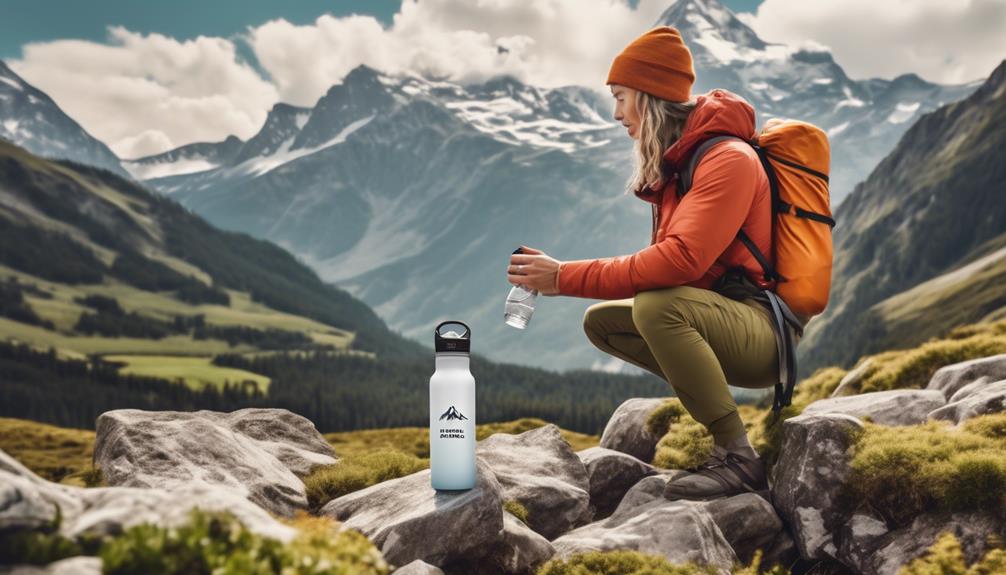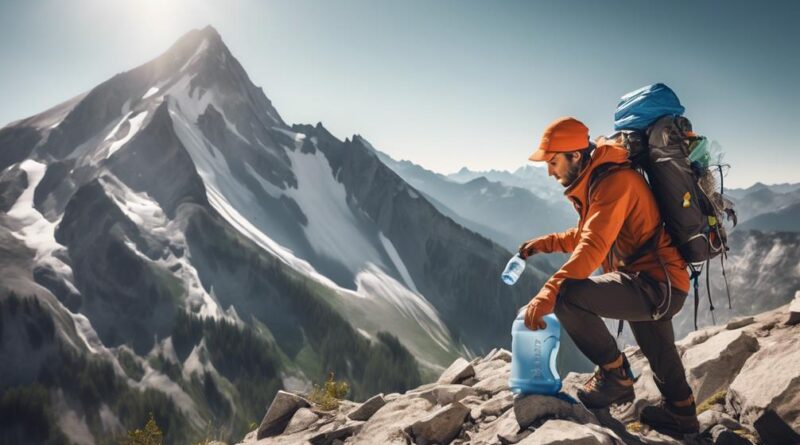Sustainable Mountain Climbing: Eco-Friendly Practices for Outdoor Travel
As the saying goes, 'Take nothing but pictures, leave nothing but footprints.' When embarking on your next mountain climbing adventure, it's essential to consider the impact of your outdoor pursuits on the environment.
By adopting sustainable and eco-friendly practices, you can minimize your ecological footprint and preserve the natural beauty of these awe-inspiring landscapes. From reducing waste to supporting local conservation efforts, there are numerous ways to make a positive difference while experiencing the thrill of outdoor travel.
But how exactly can you ensure that your mountain climbing endeavors are truly sustainable?
Leave No Trace Principles
When venturing into the mountains, always adhere to the Leave No Trace principles to minimize your impact on the environment. This means taking only photographs and leaving only footprints. As a mountain climber, it's crucial to understand the significance of minimal impact and environmental stewardship. Your actions in the mountains can have a lasting effect on the delicate ecosystem, so it's essential to be mindful of how you interact with nature.
To ensure minimal impact, always stay on designated trails and avoid trampling on fragile vegetation. By sticking to established paths, you can help preserve the natural habitat and prevent unnecessary damage to the surrounding plant life. Additionally, refrain from leaving any waste behind. Whatever you bring with you into the mountains, make sure to carry it out. This includes all food wrappers, water bottles, and any other items. Leave No Trace principles emphasize the importance of leaving the environment exactly as you found it, if not better.
Moreover, practicing environmental stewardship involves respecting wildlife. Keep a safe distance from animals and refrain from feeding them. While encountering wildlife can be an incredible experience, it's important to remember that these creatures are best admired from afar to avoid disrupting their natural behaviors.
Sustainable Gear Choices
To further reduce your environmental impact while mountain climbing, consider making sustainable gear choices that align with Leave No Trace principles. When selecting eco-friendly equipment, opt for gear made from recycled materials or items that have a minimal impact on the environment during production. Look for companies that prioritize sustainability and ethical manufacturing practices. For instance, choose climbing ropes and harnesses made from recycled materials, and select gear from companies committed to reducing their carbon footprint.
In addition to eco-friendly equipment, there are sustainable clothing options that can enhance your mountain climbing experience while minimizing environmental harm. Seek out clothing made from organic or recycled materials, as well as items that are designed to be durable and long-lasting. Choose layers that are versatile and suitable for various weather conditions, reducing the need for multiple garments. Additionally, prioritize clothing from brands that are transparent about their production processes and committed to ethical and sustainable practices.
Waste Management Strategies
Consider implementing effective waste management strategies during your mountain climbing excursions to minimize your environmental impact and preserve the natural beauty of the landscapes.
When venturing into the mountains, it's crucial to prioritize sustainable waste disposal. Utilizing composting toilets is a key step in sustainable waste management. These toilets use natural processes to break down human waste into compost, minimizing pollution and preserving the purity of mountain water sources.
Additionally, opting for biodegradable packaging for your food and supplies can significantly reduce the amount of waste you generate during your climb. Biodegradable packaging breaks down naturally over time, leaving minimal environmental footprint.
When disposing of waste, be sure to separate recyclables from non-recyclables, and always pack out what you pack in. This includes any food wrappers, containers, and other non-biodegradable waste.
By adhering to these waste management practices, you can ensure that your mountain climbing adventures have minimal impact on the fragile mountain ecosystems. Always prioritize Leave No Trace principles and strive to leave the mountains as pristine as you found them.
With conscious waste management, you can enjoy the beauty of the mountains while preserving them for future generations.
Eco-Friendly Transportation Options
Implementing eco-friendly transportation options for your mountain climbing excursions can further minimize your environmental impact and contribute to the preservation of the natural landscapes. When planning your outdoor adventures, consider the following sustainable transportation options:
- Electric Vehicles: Opt for electric vehicles when traveling to your mountain climbing destination. Electric cars produce fewer emissions than traditional gasoline-powered vehicles, reducing air pollution and minimizing your carbon footprint. Look for charging stations near your hiking or climbing spots to ensure you can power up before and after your outdoor activities.
- Bike Sharing: Embrace the use of bike-sharing programs in urban areas near your mountainous destinations. Bike sharing not only provides a convenient and eco-friendly mode of transportation for short distances but also promotes physical activity and reduces the reliance on fossil fuel-powered transportation.
- Public Transit and Carpooling: Utilize public transit options such as buses or trains when feasible. Public transit reduces the number of individual vehicles on the road, decreasing traffic congestion and emissions. Additionally, consider carpooling with fellow outdoor enthusiasts to reduce the number of vehicles traveling to the same destination, further lessening the environmental impact of your trip.
Respect for Local Wildlife
When exploring mountainous areas, remember to respect the local wildlife by observing from a safe distance and avoiding any actions that may disturb or harm the animals. Wildlife preservation is crucial in maintaining the delicate balance of mountain ecosystems. As a responsible tourist, it's essential to be mindful of the impact your presence can have on the native animals.
One of the key principles of responsible tourism is to minimize disturbance to wildlife. This means refraining from getting too close to animals or attempting to interact with them. Even seemingly harmless actions, like feeding wildlife, can have detrimental effects on their natural behaviors and diets. By keeping a safe distance and observing quietly, you can appreciate the beauty of the wildlife without causing them stress or harm.
Furthermore, it's important to stay on designated paths and trails to avoid disrupting the habitats of local wildlife. Venturing off these paths can lead to trampling of vegetation and nesting grounds, which are essential for the survival of many species. By sticking to established routes, you can minimize your impact and help preserve the natural environment for the animals that call it home.
Minimizing Carbon Footprint
To minimize your carbon footprint while mountain climbing, there are three effective ways you can follow.
- Choose Eco-Friendly Transportation: Opt for public transportation, carpooling, or electric vehicles to reach the mountain trailhead. By reducing the number of individual vehicles on the road, you can significantly decrease carbon emissions. Additionally, consider destinations that are closer to your location to minimize travel distances.
- Pack Light and Smart: Every ounce counts when it comes to reducing your carbon footprint. Pack only the essentials and invest in lightweight, durable gear. The lighter your load, the less energy is required to transport it, resulting in reduced emissions. Choose reusable containers for food and snacks to minimize waste along the trail.
- Support Green Travel Initiatives: Research and support tour operators and travel companies that actively promote eco-friendly practices. Many organizations are committed to reducing their environmental impact and support conservation efforts. By choosing to climb with these responsible operators, you contribute to sustainable tourism and conservation initiatives.
Ethical Food and Water Practices

Consider selecting locally sourced and sustainable food options to minimize your environmental impact while mountain climbing. When planning your climbing trip, prioritize ethical sourcing by choosing food and water products that are sourced responsibly and support local communities. Look for food items that are minimally packaged to reduce plastic waste. Opt for items with minimal or recyclable packaging to help in reducing plastic use and waste generation during your trip.
Additionally, consider bringing reusable containers for storing food and water to further reduce single-use plastic consumption.
When purchasing food and water supplies for your mountain climbing trip, choose products that are sourced ethically and sustainably. Look for options that support fair trade practices, as this ensures that the producers are paid fairly for their labor and helps in promoting sustainable livelihoods within the local communities. Furthermore, selecting locally sourced food and water options reduces the carbon footprint associated with transportation and supports the local economy.
Supporting Conservation Efforts
Support conservation efforts by participating in local clean-up initiatives during your mountain climbing trips. Engaging in community-led clean-up activities not only helps preserve the natural beauty of the mountains but also fosters a sense of responsibility and stewardship among climbers.
Here are three impactful ways to support conservation efforts:
- Community Engagement: Take part in organized clean-up events or collaborate with local conservation groups to contribute to the maintenance of mountain trails and surrounding areas. By working alongside community members, you can actively demonstrate your commitment to preserving the environment and encourage others to do the same.
- Environmental Education: Use your mountain climbing experiences to educate others about the importance of conservation. Share your knowledge about Leave No Trace principles, sustainable outdoor practices, and the significance of protecting fragile ecosystems. By spreading awareness, you can inspire fellow climbers to become advocates for environmental preservation.
- Advocacy and Fundraising: Get involved in advocating for policies that support conservation efforts and contribute to fundraising initiatives for environmental organizations. Your participation in raising awareness and financial support can make a meaningful impact on conservation projects and initiatives aimed at preserving mountain environments for future generations.
Frequently Asked Questions
How Can Climbers Minimize Their Impact on Fragile Alpine Ecosystems?
To minimize your impact on fragile alpine ecosystems, follow Leave No Trace and Wilderness Ethics. Dispose of waste properly, stay on designated trails, and respect wildlife. Choose eco-friendly gear and pack out all your trash.
What Are Some Sustainable Options for Shelter and Accommodation in Mountainous Areas?
When camping in mountainous areas, opt for eco-friendly shelters and practice sustainable camping. Utilize biodegradable materials, minimize waste, and leave no trace. Consider using tents made from recycled materials or sustainable alternatives to reduce environmental impact.
Are There Any Specific Guidelines for Responsible Waste Disposal in High-Altitude Environments?
When in high-altitude environments, responsible waste disposal is crucial. Always follow specific guidelines for high-altitude sanitation to ensure minimal impact on the fragile ecosystem. Pack out all waste, including human waste, and never leave anything behind.
How Can Climbers Reduce Their Reliance on Fossil Fuels During Their Mountain Expeditions?
To reduce reliance on fossil fuels during mountain expeditions, you can use renewable energy sources like solar panels and wind turbines. Additionally, consider carbon offsetting by supporting initiatives that reduce or offset carbon emissions.
What Are Some Ways to Support and Contribute to Conservation Efforts in Mountainous Regions?
To support and contribute to conservation efforts in mountainous regions, consider volunteering for local conservation projects. You can also offset your carbon footprint by using sustainable transportation options and supporting local communities through eco-friendly practices.
Conclusion
So next time you head out for a mountain climb, remember to pack sustainable gear.
Leave no trace and support local conservation efforts.
By practicing eco-friendly outdoor travel, you can help protect the natural beauty of the mountains for future generations to enjoy.
Happy climbing!
